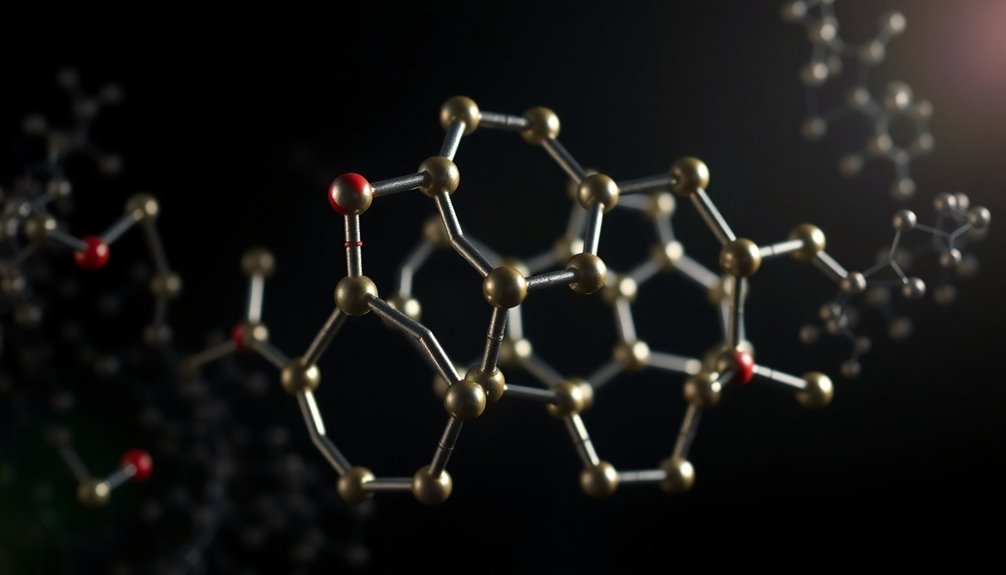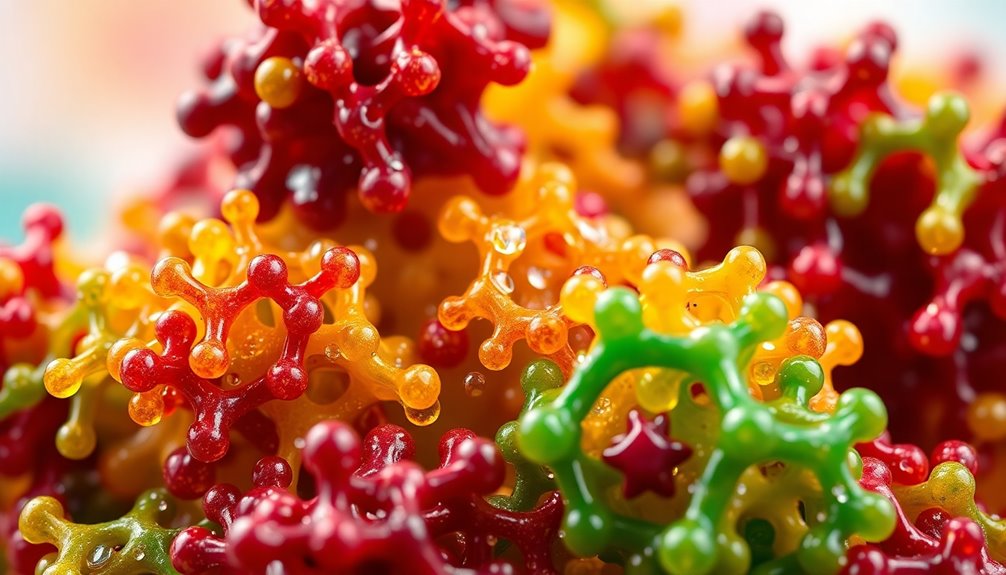Cyclooctatetraene isn't aromatic because it fails to meet vital criteria. While it has eight π electrons, it's not planar. Its tub-shaped conformation minimizes steric strain, but this non-planarity disrupts p orbital overlap, which is essential for resonance stabilization. According to Hückel's Rule, a compound needs to be cyclic, planar, and follow the 4n + 2 rule to be aromatic. COT's structure leads to antiaromatic characteristics instead, resulting in higher energy and instability. Understanding these factors helps clarify why COT behaves differently from aromatic compounds. There's much more to explore about its unique properties and implications.
Key Takeaways
- Cyclooctatetraene (COT) has 8 π electrons, conforming to the 4n rule, but is not planar, violating Hückel's criterion for aromaticity.
- The non-planar, tub-shaped conformation of COT prevents effective overlap of p orbitals necessary for resonance stabilization.
- COT's internal bond angles exceed 120 degrees, indicating a deviation from ideal sp² hybridization, further contributing to its non-aromatic nature.
- The chair-like conformation minimizes steric strain but leads to antiaromatic characteristics, resulting in instability compared to aromatic compounds.
- COT's lack of aromatic stabilization affects its reactivity, leading to unique reactions in organic synthesis and materials science.
Structure of Cyclooctatetraene
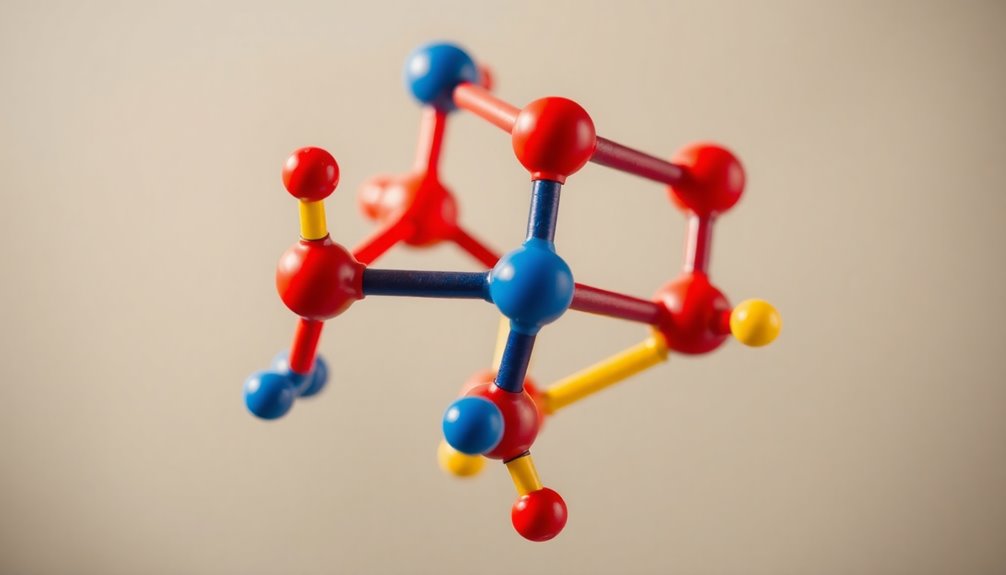
Cyclooctatetraene (COT) features a unique structure with eight carbon atoms arranged in a cyclic formation that showcases alternating double bonds. This molecule's internal angles exceed 120 degrees, leading to a non-planar, tub-shaped conformation rather than a flat, planar structure.
This non-planarity prevents effective overlap of p orbitals, which is essential for aromaticity. Although COT has eight π electrons, its structure avoids the conditions necessary for aromatic stabilization. Instead, its lowest energy conformation resembles a chair, minimizing steric and angle strain, further confirming its non-aromatic classification.
The carbon atoms primarily exhibit sp² hybridization, yet the non-planar arrangement results in bond angles and lengths that diverge from the ideal sp² geometry, highlighting its unique structural characteristics.
Hückel's Rule Explained
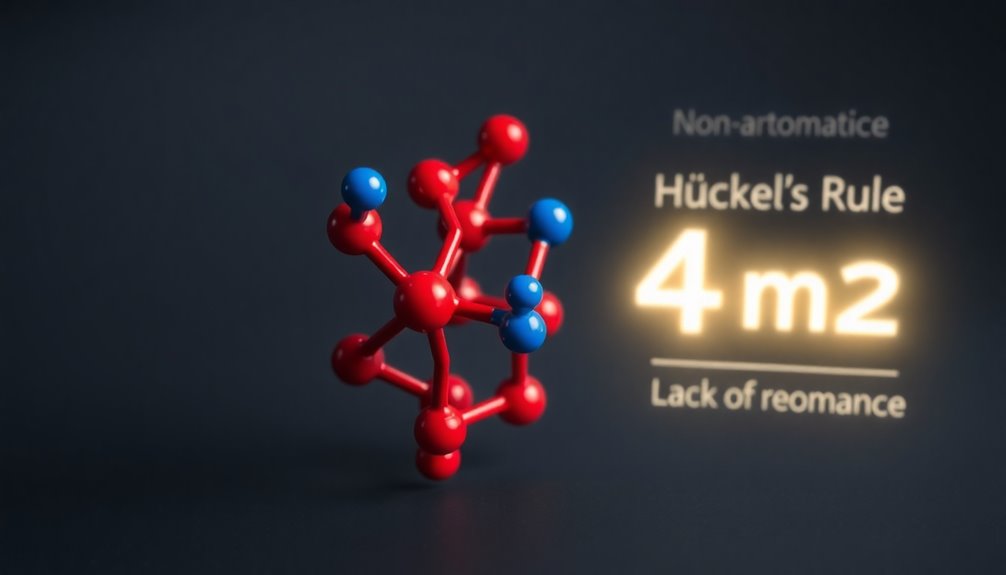
Understanding Hückel's Rule is vital for determining whether a compound is aromatic. According to Hückel's rule, a compound must be cyclic, planar, and have 4n + 2 π electrons to be classified as aromatic, where n is a non-negative integer.
Cyclooctatetraene, with its 8 π electrons, follows the 4n formula (where n=2), meaning it doesn't meet the 4n + 2 requirement. Additionally, its tub-shaped non-planar conformation prevents effective overlap of p orbitals, which is essential for the delocalization of π electrons.
As a result, cyclooctatetraene is classified as antiaromatic, leading to instability and higher energy compared to aromatic compounds. This failure to adhere to Hückel's Rule greatly influences its chemical behavior and reactivity.
Non-planarity and Stability
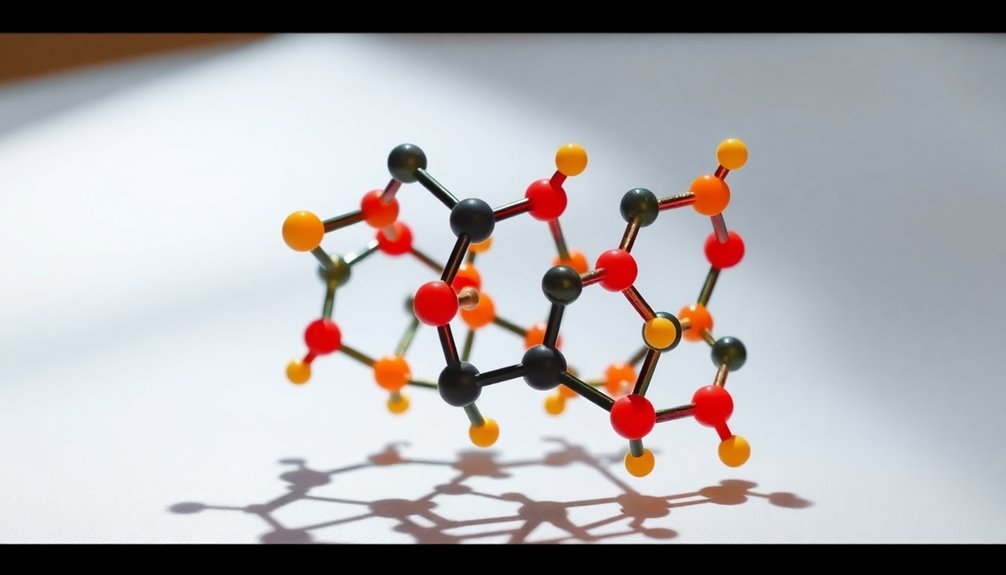
When you look at cyclooctatetraene, you'll notice it adopts a chair-like conformation that keeps it non-planar.
This shape considerably impacts its electronic configuration and helps minimize steric strain, which contributes to its stability.
Chair-like Conformation
Although it might seem counterintuitive, the chair-like conformation of cyclooctatetraene (COT) plays an essential role in its stability. By adopting a non-planar structure, COT avoids the destabilizing effects of antiaromatic compounds associated with its 8 π-electrons. This conformation minimizes steric and angle strain, making it energetically favorable compared to a hypothetical planar form.
| Property | Description | Importance |
|---|---|---|
| Chair-like Conformation | Non-planar structure | Prevents antiaromatic destabilization |
| Internal Angles | Exceed 120 degrees | Reduces overlap of p orbitals |
| Lowest Energy Conformation | Tub shape | Minimizes strain and instability |
| π-Electron Count | 4n (n=2) | Contributes to antiaromaticity risk |
This non-planarity is vital for COT's stability.
Electronic Configuration Impact
The electronic configuration of cyclooctatetraene (COT) greatly influences its stability, primarily due to its non-planar structure. COT has 8 π electrons, which, according to Hückel's rule, disqualifies it from being aromatic since it doesn't meet the 4n + 2 requirement.
In a planar arrangement, COT would act as an antiaromatic compound, leading to significant destabilization because of its 8 π electrons. This configuration increases energy levels, making it less stable.
The non-planar, tub-shaped conformation minimizes steric strain and hinders the overlap of p orbitals, essential for maintaining aromatic stabilization through delocalization in molecular orbitals. This energetic stability in its non-planar form is favored by about 12 kcal/mol over a hypothetical planar structure.
Steric Strain Considerations
To understand the stability of cyclooctatetraene (COT), it's crucial to contemplate how its non-planar, tub-shaped conformation minimizes steric strain.
By adopting this shape, COT effectively reduces angle strain, as the internal bond angles exceed the ideal sp² hybridization angle of 120 degrees.
If COT were planar, it would face significant destabilization due to antiaromatic characteristics associated with having 8 π electrons.
The tub shape favors stability, resulting in an energy difference of about 12 kcal/mol between the planar and non-planar forms.
This non-planarity circumvents the unfavorable overlap of p orbitals that could lead to antiaromaticity, ensuring that COT remains stable and avoids the increased instability associated with steric strain.
Comparison With Aromatic Compounds

When you compare cyclooctatetraene (COT) with aromatic compounds like benzene, the differences in planarity and electron count become clear.
COT's 8 π electrons fail Hückel's rule, while stable aromatic compounds typically have 6 π electrons and maintain a planar structure.
This lack of planarity in COT not only prevents delocalization but also contributes to its instability as a non-aromatic compound.
Planarity and Stability Factors
While cyclooctatetraene (COT) contains eight π-electrons, it fails to exhibit the planarity and stability characteristic of aromatic compounds like benzene. COT adopts a non-planar tub shape to minimize steric strain and avoid antiaromaticity.
In a planar form, it would present antiaromatic characteristics, destabilizing the molecule due to its 4n π-electron configuration. The internal bond angles in COT exceed the ideal 120 degrees of sp² hybridization, reinforcing its non-planar structure.
Unlike planar aromatic compounds that benefit from resonance stabilization, COT's shape hinders effective overlap of p orbitals. This lack of delocalization means it can't achieve the aromatic stability seen in compounds like benzene, ultimately defining its non-aromatic nature.
Electron Count Comparison
Although cyclooctatetraene has eight π-electrons, it doesn't meet the criteria for aromaticity that compounds like benzene do. Instead, it adheres to the 4n rule, indicating potential antiaromatic characteristics.
Aromatic compounds, such as benzene, follow Hückel's rule with 6 π-electrons (4n + 2), leading to their stability.
Cyclooctatetraene's non-planar, tub-shaped conformation disrupts effective overlap of p orbitals, preventing delocalization of its π-electrons. This lack of overlap results in uneven bond lengths, further undermining stability.
Unlike aromatic compounds that benefit from delocalization and stabilization, cyclooctatetraene's non-planarity and π-electron count lead to an unstable configuration, classifying it as non-aromatic.
Consequently, its electron count comparison highlights its distinct lack of aromatic properties.
Antiaromaticity and Cyclooctatetraene
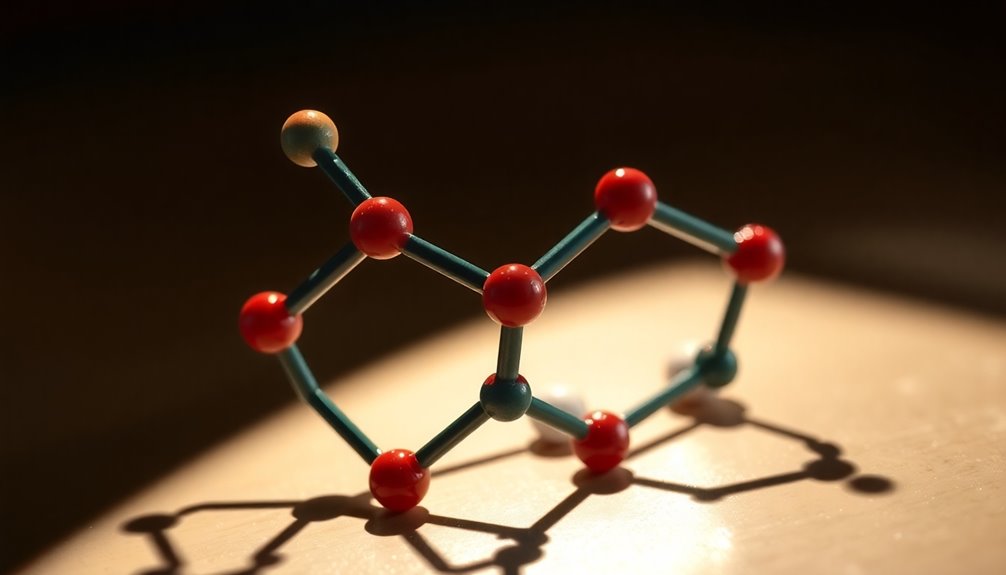
Cyclooctatetraene (COT) stands out in organic chemistry due to its unique classification as non-aromatic, primarily because it possesses 8 π-electrons that fit the 4n rule for antiaromaticity. The cyclooctatetraene molecule adopts a non-planar tub shape, which minimizes angle and steric strain. This structure prevents the overlap of p orbitals needed for resonance stabilization.
| Property | Cyclooctatetraene | Implication |
|---|---|---|
| π-electrons | 8 (4n rule) | Fits antiaromatic criteria |
| Energy Conformation | Chair-like structure | Enhances stability |
| Unpaired Electrons | Not significant | Lacks resonance stabilization |
Implications for Chemistry
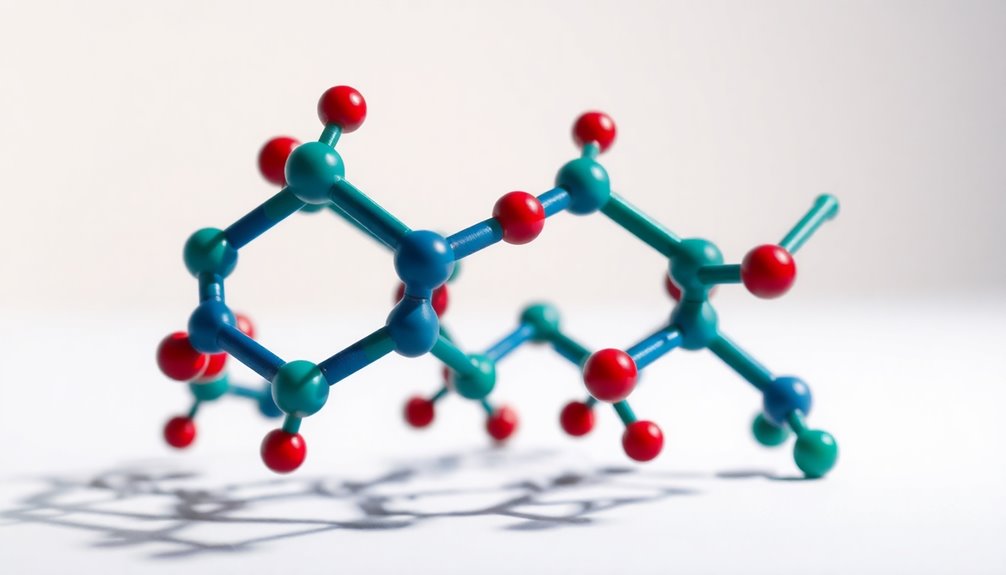
Understanding the implications of cyclooctatetraene's non-aromatic nature is essential for chemists exploring the behavior of cyclic compounds.
Since COT is classified as non-aromatic due to its tub-shaped conformation, it can't achieve the necessary overlap of p orbitals for aromatic stabilization. With 8 π-electrons, it fits the 4n rule but not Hückel's criterion for aromaticity.
This non-planarity minimizes angle strain and steric interactions, helping the molecule avoid the destabilizing effects of antiaromaticity. Recognizing these factors informs your understanding of the energy differences between aromatic and non-aromatic compounds, influencing chemical reactivity.
Ultimately, COT's classification as non-aromatic shapes its potential applications in organic synthesis and materials science, paving the way for innovative discoveries.
Frequently Asked Questions
Why Is Cyclohexane Not Aromatic?
Cyclohexane isn't aromatic because it lacks π-electrons due to its single bonds, which means there's no potential for electron delocalization.
Its non-planar chair conformation also prevents the necessary overlap of p orbitals, essential for aromaticity.
With 12 hydrogen atoms and 6 carbon atoms, cyclohexane is saturated and doesn't meet Hückel's rule of 4n + 2 π-electrons.
As a result, it exhibits typical alkane reactivity rather than the stability of aromatic compounds.
Why Is Cycloheptatriene Non-Aromatic?
Imagine trying to dance in a crowded room where everyone's moving in different directions.
That's like cycloheptatriene's structure—it's got 6 π electrons but can't form a stable, aromatic dance because it's non-planar.
The internal angles exceed the ideal 120 degrees, preventing necessary p orbital overlap.
Without that overlap, you can't achieve the resonance stabilization that makes aromatic compounds so special, leaving cycloheptatriene non-aromatic and out of sync with true aromaticity.
Why Doesn't Cyclooctatetraene Show Resonance?
Cyclooctatetraene doesn't show resonance because it adopts a non-planar, tub-shaped conformation. This shape minimizes strain but prevents effective overlap of p orbitals.
You'll find that the internal angles exceed the ideal sp² hybridization angle, which further disrupts potential resonance.
Additionally, the presence of unpaired electrons in non-bonding orbitals complicates matters, making it less stable than more aromatic compounds.
Why Is Cyclooctatetraene Not Conjugated?
Imagine a dance where partners can't fully connect; that's cyclooctatetraene.
You see, its non-planar structure prevents effective overlap of p orbitals, which is essential for conjugation. Instead of forming a smooth, flowing bond like in aromatic compounds, the angles create a disruption.
This lack of alignment means the electrons can't freely move across the molecule, leading to a failure in achieving the continuous electron cloud typical of conjugated systems.
Conclusion
To summarize, cyclooctatetraene isn't aromatic because it doesn't meet the conditions laid out by Hückel's rule. Its non-planar structure keeps it from achieving the stability that aromatic compounds enjoy. Unlike those compounds, cyclooctatetraene dances on the edge of antiaromaticity, making its behavior quite unique in the world of chemistry. Understanding these distinctions helps you appreciate the intricate nature of molecular structures and their impact on chemical properties.

